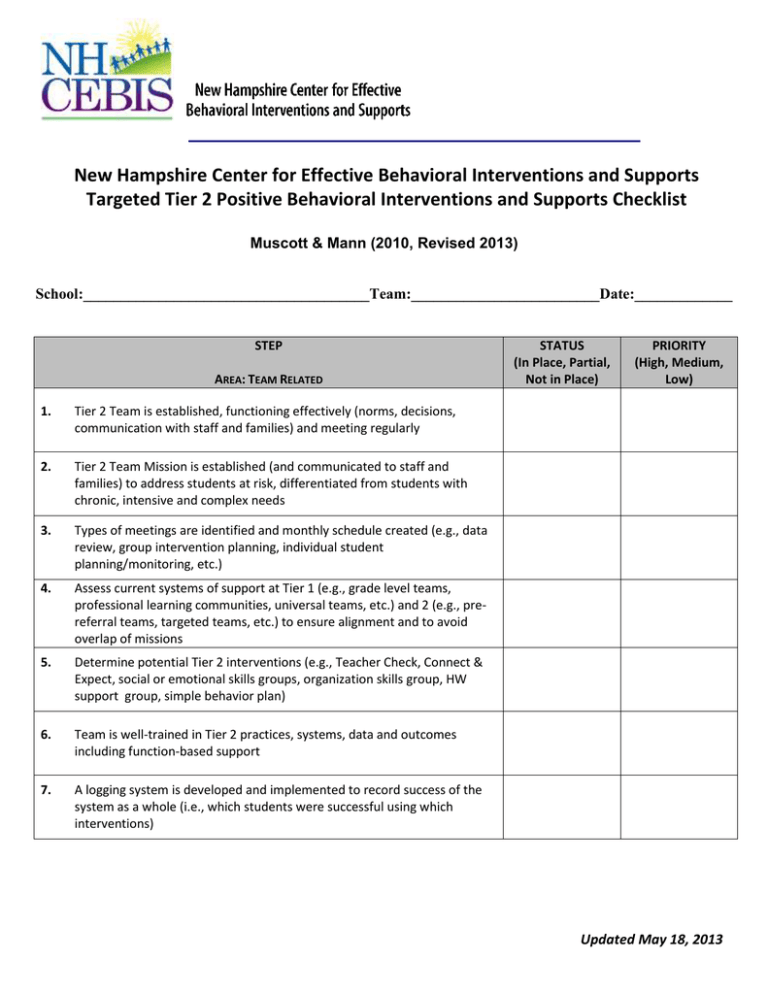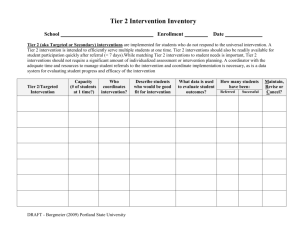New Hampshire Center for Effective Behavioral Interventions and Supports
advertisement

New Hampshire Center for Effective Behavioral Interventions and Supports Targeted Tier 2 Positive Behavioral Interventions and Supports Checklist Muscott & Mann (2010, Revised 2013) School:______________________________________Team:_________________________Date:_____________ STEP AREA: TEAM RELATED 1. Tier 2 Team is established, functioning effectively (norms, decisions, communication with staff and families) and meeting regularly 2. Tier 2 Team Mission is established (and communicated to staff and families) to address students at risk, differentiated from students with chronic, intensive and complex needs 3. Types of meetings are identified and monthly schedule created (e.g., data review, group intervention planning, individual student planning/monitoring, etc.) 4. Assess current systems of support at Tier 1 (e.g., grade level teams, professional learning communities, universal teams, etc.) and 2 (e.g., prereferral teams, targeted teams, etc.) to ensure alignment and to avoid overlap of missions 5. Determine potential Tier 2 interventions (e.g., Teacher Check, Connect & Expect, social or emotional skills groups, organization skills group, HW support group, simple behavior plan) 6. Team is well-trained in Tier 2 practices, systems, data and outcomes including function-based support 7. A logging system is developed and implemented to record success of the system as a whole (i.e., which students were successful using which interventions) STATUS (In Place, Partial, Not in Place) PRIORITY (High, Medium, Low) Updated May 18, 2013 STEP 8. AREA: EARLY IDENTIFICATION AND ACTIVATION Determine criteria for Tier 1 non-responsiveness and any decision rules regarding implementation of previous interventions (i.e., what must be tried prior to T2 nomination) 9. Determine a protocol for teacher nomination and develop aligned form(s) 10. Staff are trained in how to nominate for Tier II supports 11. Develop a quick data review process to implement upon nomination to T2 system 12. Determine behavioral indicators and cut scores (e.g., how many major office referrals triggers consideration for Tier 2 nomination) 13. Determine whether to use a systematic screening process to identify candidates for Tier 2 14. If using systematic screening, determine tools, process, and procedures for training and implementation including addressing parent consent 15. Determine post-screening team, teacher schedule for post-screening review meetings, procedures for assessing the results of screening, and decisions that can be made at the post-screening review meetings STEP AREA: INTERVENTIONS 16. Decide whether an efficiently accessed intervention (e.g., Teacher Check, Connect and Expect) will be used initially for all T2 activated students unless counter-indicated 17. Determine minimal amount of information that must be included in a simple student behavior plan (e.g., current level, intervention, success indicator, timeline) 18. Determine decision rules on density of service (e.g., length of sessions, times per week and number of weeks) and what constitutes success for each intervention 19. Determine which staff will coordinate or lead each intervention including provision of coaching support STATUS (In Place, Partial, Not in Place) PRIORITY (High, Medium, Low) STATUS (In Place, Partial, Not in Place) PRIORITY (High, Medium, Low) Updated May 18, 2013 STEP AREA: INTERVENTIONS ‘CONTINUED’ 20. If an efficient initial intervention is to be assigned (unless counterindicated) at the point of T2 activation, determine what intervention is and train and coach staff in the intervention (e.g., TCCE, Simple Plan, etc.) 21. Determine, train and coach staff in the purpose of group interventions 22. Determine, train and coach staff in function-based perspective and basic function-based behavioral support planning STEP AREA: ASSESSMENT AND DATA 23. If screening will occur, determine the frequency and approximate schedule for school-wide screening (e.g., 2 times a year in fall and spring; quarterly, etc.) 24. Effectively and regularly assess and report to staff fidelity of implementation of all interventions and processes 25. Regularly log interventions and progress data on students being served 26. Schedule Tier 2 progress monitoring meetings (every 4-6 weeks) using student progress data (organized by each intervention ‘lead’) 27. Regularly survey staff for feedback to improve communication and Tier 2 systems 28. Survey families for feedback to improve communication and Tier 2 systems STATUS (In Place, Partial, Not in Place) PRIORITY (High, Medium, Low) STATUS (In Place, Partial, Not in Place) PRIORITY (High, Medium, Low) Updated May 18, 2013 Tier 2 Positive Behavioral Interventions and Supports Checklist Action Planning Worksheet Item(s) to Address Action to be Taken By Whom By When Updated May 18, 2013




